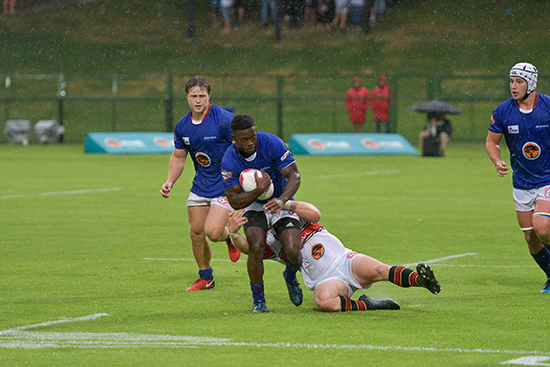Latest News Archive
Please select Category, Year, and then Month to display items
31 January 2018
Photo FNB Varsity Cup
 Lubabalo Dobela, Shimlas flyhalf (with the ball), played a key role in the Shimlas’ win over Tuks in the first round of the 2018 Varsity Cup.
Lubabalo Dobela, Shimlas flyhalf (with the ball), played a key role in the Shimlas’ win over Tuks in the first round of the 2018 Varsity Cup.
The Shimlas made a huge statement in their opening match of the 2018 Varsity Cup when they defeated last year’s champions at the Tuks Rugby Stadium in Pretoria.
The Free State students won the encounter against Tuks by 19-17 on Monday.
Tuks, who beat Shimlas twice last year, first in the group stage by 65-19, and then by 28-21 in the semifinals, were regarded as the hot favourites. The match was played in wet conditions which many thought would suit the home team better.
Determination carries team to win
But a young and inexperienced Shimlas team with 11 players making their debut in the competition proved that big hearts and guts count for just as much. It was only their third win in Pretoria in the 11th year of the competition and their second victory over Tuks since 2012.
As expected, both teams tightened up their approach. Shimlas struck back from a 0-5 deficit soon after the first strategy break as big and speedy wing Francois Agenbag stormed down the touchline to score a seven-point try. Flyhalf Lubabalo Dobela was on hand to convert and hand his team a 9-5 lead at the break.
Flyhalf stars in debut
The Shimlas extended their lead within five minutes of the restart as flank Benji Janse van Vuuren crashed over in the corner for a converted try. Dobela, one of the debutants who was named Player that Rocks (Player of the Match), controlled the match like a seasoned veteran. Apart from two difficult conversions from the touchline, he also slotted a penalty goal.
Childhood obesity should be curbed early
2017-03-15

Serious intervention by parents is required to deal
with childhood obesity. Prof Louise van den Berg and
a group of final-year PhD students worked on a study
about the prevalence of obesity in six-year-olds in
South Africa.
Photo: Supplied
If your child is overweight when they start school at the age of six, unless you do something about it at that point, the indications are they are going to be overweight teenagers and obese adults. This is according to University of the Free State’s Prof Louise van den Berg.
Evidence has shown that overweight children and teenagers have a greater risk of developing lifestyle diseases such as type 2 diabetes, hypertension and cardiovascular disease later in life, and dying prematurely.
Obesity is a global pandemic rapidly spreading among adults and children, in developed and developing countries alike.
Dr Van den Berg worked with Keagan Di Ascenzo, Maryke Ferreira, Monja-Marie Kok, Anneke Lauwrens, all PhD students with the Department of Nutrition and Dietetics, to conduct the study. Their research found that children who are overweight by the time they turn six should be screened for weight problems.
Why six-year-olds?
Children who are overweight between the ages of two and five are five times more likely to be overweight when they are 12. There are two periods in a normal life cycle when the body makes new fat cells. The first is in the uterus and the second is around the age of six. The second phase lasts from the age of six to puberty.
The study assessed the prevalence of obesity in six-year-olds as part of a campaign in South Africa to raise awareness of the problem among parents and educators.
A total of 99 children were chosen from seven schools in Mangaung, the capital city of Free State. The schools were chosen from quintile four and five schools, which when measured by their own resources and economic circumstances, are well resourced and serve largely middle-class and wealthy communities.
The children’s weight, height and waist circumference were measured and used to calculate a body mass index score and waist-to-height ratio. Both these figures are good predictors for future lifestyle disease risks such as type 2 diabetes, hypertension and cardiovascular disease. A person with a good waist-to-height ratio can wrap a piece of string equal to their height around their waist at least twice.
When the children had a higher body mass index, they also had an increased waist to height ratio. The study found one in four children from the schools surveyed were overweight when they started primary school.
Nipping the fat in the bud
Although there are many factors that play a role in preventing childhood obesity, parents’ perceptions of their children’s weight play an important role. A recent study found that more than 50% of parents underestimate the weight of their obese children. These parents remain unaware of the risks their children face and are not motivated to take any action.
At least half of the parents whose children are overweight struggle to recognise their children’s weight problems fearing that they will be labelled or stigmatised. By the time they turn six overweight children should be referred to dieticians and nutritionists who are qualified to guide their parents in getting them to eat well and be more physically active at pre-primary and primary school.
The high prevalence of weight problems among six-year-olds found in this study is an urgent call to healthcare professionals to step up and empower parents, educators and children with the necessary skills for healthy dietary practices and adequate physical activity.